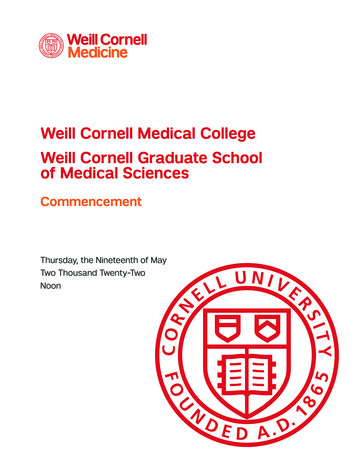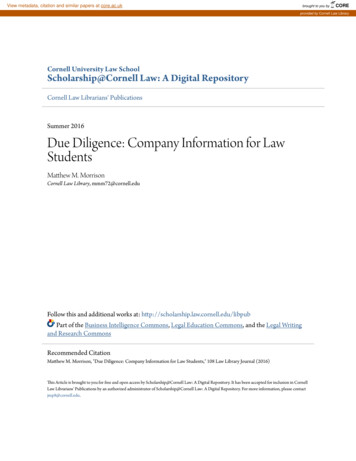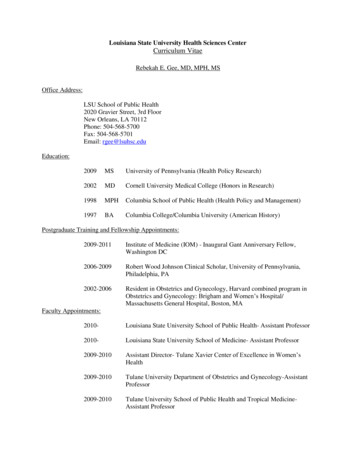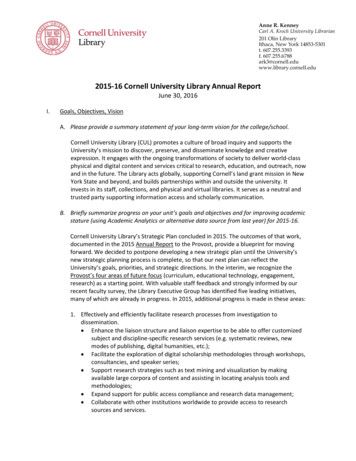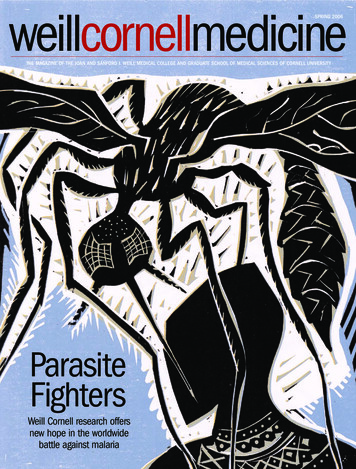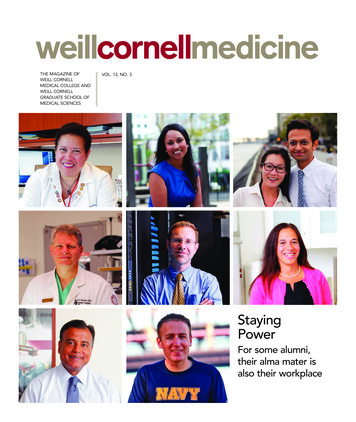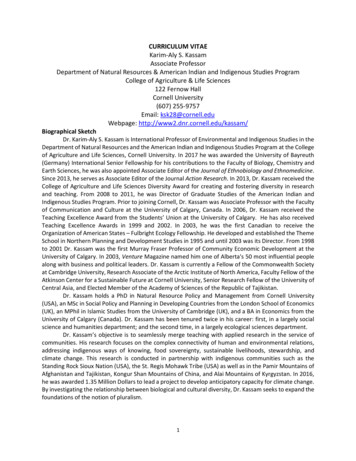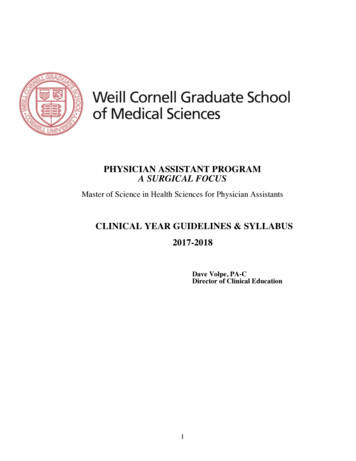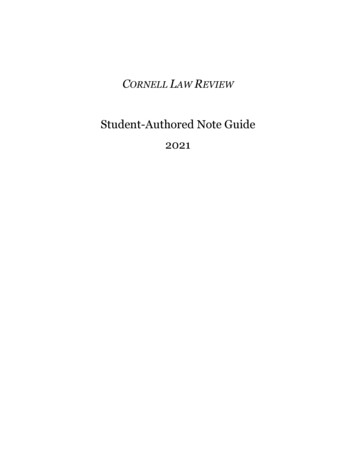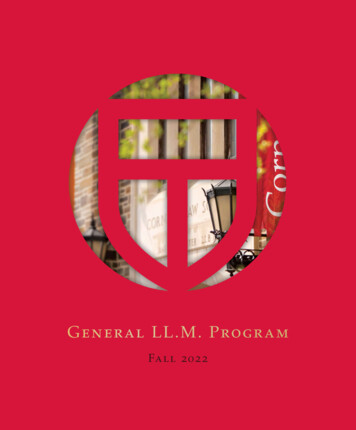
Transcription
Cornell Law SchoolMyron Taylor HallIthaca, NY 14853-4901Phone: 607.255.5141 Fax: 607.255.7193 Email: lawadmit@lawschool.cornell.eduWebsite: www.lawschool.cornell.eduTHE BASICSCornell admitted its first law students in 1887. Theschool’s “Department of Law” was accredited by theABA in 1923, it officially became a graduate school in1924, and Cornell Law School was formally establishedin 1925.The school is located in Ithaca, NY, about a 4-hour drivefrom New York City, and 45 minutes from any interstatehighway. Ithaca is primarily a rural area, dominated byits student residents.The school’s tuition is just over 51,000, and estimatedyearly living expenses are around 17,000.Application deadline: 11/2 (Early); 2/1 (Regular)Application fee: 80Financial aid deadline: 3/15Type of school: PrivateTuition and fees: 51,510 (2010 - 2011)Admissions: Rolling (most decisions by early April)Acceptance percentage: 21% (2009)Incoming class size: 205Early Action/Early Decision available: Yes, non-bindingPart-time program available: NoDespite its Ivy League status, Cornell’s admissionsrequirements are a little less stringent than those ofYale, Harvard, and Columbia, providing easier access tothe Ivy’s than at some other members of the League.GPA AND STANDARDIZED TESTSAlthough Cornell Law is small (with a total JD enrollmentof just over 600 students), it has the kind of academicand extracurricular offerings you might expect at a muchbigger institution: 11 clinics, 15 study abroad programs,4 externship opportunities, 7 joint-degree programs,and 4 scholarly student-edited journals, in addition toalmost 40 student groups and organizations.GPA 25th - 75th percentile range: 3.48 - 3.80Cornell Law boasts one of the lowest law school studentto-faculty ratios in the nation (10 to 1). Among morethan 100 professors on the faculty, many are nationallyrenowned experts in their fields, and almost all havebeen published in multiple academic and legal journals.Cornell Law SchoolLSAT 25th - 75th percentile range: 165 - 168TOEFL not required for international applicants.APPLICATION REQUIREMENTSLetters of recommendation: 2 requiredRequired essays: Personal statement (2-page limit)Optional essays: Diversity essayDean’s Certification: Required for matriculating studentsAdditional documentation: Some applicants mayreceive evaluative interview requests.1
Cornell Law: The PowerScore PerspectiveThe “reachable” IvyYou can’t hide hereCompared to the other Ivy League law schools on this list(Columbia, Harvard, Penn, and Yale), Cornell is definitelythe most accessible, both in terms GPA and LSAT mediansand in terms of acceptance percentages. With averageLSATs below 170, and average GPAs below 3.9, those withnon-Ivy credentials looking for an ivory tower degree mayhave a shot with Cornell.The small community also impacts your law school socialexperience. If your goal is to go to a school where youcan blend in with the scenery and not attract attention,you might be better off choosing a different school. Everyfish is a big fish in this small pond. Cornell takes the wellbeing of its students seriously, and fosters a feeling ofcollegiality through plentiful student gatherings and astrong student organization network. Expect to know all ofyour classmates within just a few weeks, and expect themto want to get to know you.But, the secret’s outHowever, those “lower” numbers may begin to change,and soon. Cornell’s Ivy League status and small townappeal have translated into steady increases in applicantnumbers. In 2010, Cornell Law’s application numbers were52.5% higher than the year before. The school’s popularityis growing rapidly, and as that continues the competitionfor spots will also continue to grow. Ithaca—it’s no New York CityCornell is located in Ithaca, asomewhat small town in rural midstate New York. Outside of CornellUniversity and Ithaca College, there’snot much in Ithaca, which personifiessmall-town America. With theentertainment offerings limited inIthaca, Cornellians typically look totheir university environs for activitiesand excitement.An approachable facultyAnd, this desire to get to know you comes from a genuinelygood place. Add Cornell Law to the list of law schools thatare actually friendly. As one current student pointed out,people here just tend to be nice to one another; the smallcommunity clearly perpetuates a supportive and friendlyatmosphere. In a school this tight,the Golden Rule reigns supreme.Add Cornell Law to thelist of law schools thatare actually friendly.“We’re all nice to eachother because we likeoneanother,”onestudent shared, adding“.but even if we didn’t,you can’t exactly bemean and get away withit—the class is too small;we’d all find out.”There are benefits to this smallcommunity,particularlywhencombined with an excellent studentto-faculty ratio: The teachers aremore than just pedagogues; studentsreport warm, friendly interactionswith their instructors, regardlessof tenure. Lectures are lively, andprofessors’ doors are always open. Questions are metwith interest and a desire to help. Classes can be toughand demanding, but the students sincerely seem to enjoythe education.A cozy (limiting?) environmentHowever, there is a negative aspect to all this closeness:compared to larger law schools like American and Harvard,the variety of academic disciplines is much narrower, andthe faculty roster is smaller. This results in a more limitedrange of classes. While the school does a good job ofoffsetting these limitations with lots of visiting professors,smaller seminars on topical themes, and an array of nonlegal classes, Cornell likely won’t have the kind of classvariety found at some of the bigger law schools.2It’s a wonderful lifeGorgeous gorgesAnd so does Mother Nature. Cornell’scampus is one of impressive naturalbeauty, and its gorges are one of theprimary attractions (a fact Ithacareadily and cheekily recognizesthrough its pervasive slogan, “IthacaIs Gorges.” Say it fast a few timesand you’ll get it). The Fall Creek andCascadilla Gorges, carved by glaciersthousands of years ago, frame twosides of the university’s grounds.With the Cayuga River runningthrough campus, and multiple creeksand waterfalls wending their waythrough the gorges, the sound ofrunning water is a constant backdropto life at the school. The campus risesorganically from this nature-bound home, and makes eventhe harshest winter weather seem oddly majestic.Harry Potter was here?The school’s stone exterior and high-ceilinged interior,and the law library in particular, have been comparedto the Hogwarts School of Harry Potter fame, and nicelycomplements the school’s splendid natural surroundings.Ooh, frosty!The winters can definitely be rough. Although it may notseem like something worth considering to some, it bearsmentioning that weather isn’t one of Ithaca’s strong suits:in January and February the average low temperature isin the teens. If snowy, drab, and cold isn’t your cup of tea,you may need to consider a different path to your JD.The PowerScore Guide to the Top U.S. Law Schools
Cornell Law: The NumbersACCEPTANCE RATESFull-time: 21% (900 of 4,207 admitted)Part-time: N/AGPA AND LSAT SCORESGPA - 75th percentile: 3.80GPA - Median: 3.63GPA - 25th percentile: 3.48CAREER SERVICESOn-campus Career Services Office? YesNumber of full-time career services staffers? 4Career services specializations: Firms, corporations,government, public interest, non-profits, the judiciaryOn-Campus Interview (OCI) program? Yes, in the fall for2Ls and 3Ls.EMPLOYMENT STATISTICS*LSAT - 75th percentile: 168LSAT - Median: 167LSAT - 25th percentile: 165ENROLLMENT AND ETHNICITYAfrican-American: 11 (M); 27 (F); 6.1% of student bodyAmerican Indian: 3 (M); 5 (F); 1.3% of student bodyAsian-American: 24 (M); 61 (F); 13.7% of student bodyCaucasian: 204 (M); 172 (F); 60.5% of student bodyHispanic: 13 (M); 14 (F); 4.3% of student bodyMexican-American: 10 (M); 11 (F); 3.4% of student bodyPuerto Rican: 5 (M); 5 (F); 1.6% of student bodyInternational: 30 (M); 27 (F); 9.2% of student bodyNon-Reported: 0 (M); 0 (F); 0.0% of student bodyTRANSFERS (FIRST-YEAR) AND ATTRITIONTransfers in: 10Transfers out: 41L attrition: 4 (0 Academic, 4 Other)2L attrition: 03L attrition: 0FINANCIAL AIDMerit aid available? NoGrants and scholarships available? YesStudents receiving grants: 218, 36.9% of student bodyMedian grant amount: 18,000.00LRAP program available? YesCornell does not offer merit-based aid, but it does haveover 3 million dollars available in institutional need-basedaid that it distributed to new and returning students everyyear. Students are encouraged to submit Need Accessforms in order to be considered for aid.LIBRARY RESOURCESWireless network availability? YesNumber of wired connections available: 32Hours per week the library is open: 168Study seating capacity inside the library: 419Number of full-time professional librarians: 9Cornell Law School*All statistics are 9 months after graduationEmployment status known: 186, 100.00% of classEmployment status unknown: 0, 0.0% of classEmployed: 182, 97.8% of classPursuing graduate degrees: 0, 0.0% of classUnemployed: 3, 1.6% of classTYPE OF EMPLOYMENTAcademia: 1, 0.5% of classBusiness and Industry: 0, 0.0% of classGovernment: 3, 1.6% of classJudicial Clerkship: 16, 8.8% of classLaw Firms: 156, 85.7% of classPublic Interest: 6, 3.3% of classGEOGRAPHIC LOCATIONThe Northeast is the biggest employment market forCornell Law graduates, with the bulk of students (59%)working within the state of New York.Students employed in-state: 59.9%Students employed in foreign countries: 2.2%Number of states where students are employed: 21Class of 2009 graduates were employed in 21 states.In addition to the Northeast U.S., students were alsoemployed in the West/Southwest (11%), Great Lakes/Plains (6%), and Southeast (5%).ALUMNI NETWORKCornell has over 9,000 alumni all over the world, employedin all areas of the law: the judiciary, government, academiaand business. Alumni are encouraged to remain in contact,and host networking events for both old and new alums.BAR PASSAGE RATESFirst-time takers: 187 (70.59% reporting)Average school pass rate: 99.24%Average state pass rate: 88.98%Average pass rate difference: 10.26%3
Cornell Law: The SchoolThe small incoming class size, an academically-laudedfaculty, and an exceptionally low student-to-faculty ratiocombine at Cornell Law to create a unique learningenvironment. Combine that with Cornell’s Ivy Leaguereputation, and it’s easy to see why the schools law schoolapplication numbers continue to steadily rise.Incoming class size: 205 (2009)Typical first-year section size: 30-35CURRICULUMCornell Law requires that first-year students take CivilProcedure, Constitutional Law, Contracts, Criminal Law,Property, Torts, and Lawyering.The Lawyering course is Cornell’s name for the standardlegal research and writing first-year class common toalmost all law schools. Cornell’s version adds its own twistto the course: Assignments are usually set in the contextof a simulated law office (or judge’s chambers). Studentsprepare and write memoranda, and argue them beforea panel. Throughout the year, students also learn thefundamentals of legal research. Instruction occurs not onlyin full-class sessions but also in individual conferences,and students receive extensive feedback on each majorassignment.In the second and third years, all courses are elective,although some courses must be taken in ethics andadvanced legal writing.FACULTYACADEMIC OPPORTUNITIESCLINICS AND EXTERNSHIPS: Cornell Law currently haseleven clinical programs: Capital Punishment (PostConviction Litigation), Immigration Appellate Law andAdvocacy, Criminal Defense, International Human Rights,Labor Law, Legal Aid, Prosecution, The Regulation Room(and “an online environment for people and groups tolearn about, discuss, and react to selected regulationsproposed by federal agencies”), Securities Law, U.S.Attorneys Office, and Water Law. In addition, the schooloffers four externships available to second- and third-yearstudents (Judicial Externship, Law Guardian Externship,Legislative Externship, and Neighborhood Legal ServicesExternship), as well as the opportunity for students tocraft their own full-year legal externship.STUDY ABROAD: Cornell Law currently has 15 studyabroad semester opportunities with “partner” schools allover the world. Students are also welcome to create theirown programs with prior approval from the school.JOINT DEGREE: Cornell Law offers traditional MBA, MPA,MRP, MILR, PhD, and MA joint degrees, in addition to a3-year JD/MBA joint degree.JOURNALS AND PUBLICATIONSCornell Law has four student-edited journals (CornellInternational Law Journal, Cornell Journal of Law andPublic Policy, Cornell Law Review, and LII Bulletin), andone faculty-edited publication (Journal of Empirical LegalStudies).MOCK TRIAL AND MOOT COURTStudent-to-faculty ratio: 10 : 1Cornell Law has over 100 permanent, emeritus, clinical,visiting, adjunct, and associated faculty members, many ofwhom have had an impact reaching far beyond the wallsof the school. Its faculty includes:Cornell Law has a student-run Moot Court Board thatorganizes three internal competitions and fields teamsfor several external and international moot courtcompetitions.Robert S. Summers, expert on UCC and contract law;Gregory Alexander, expert on property, trusts, and estates;Valerie Hans, leading authority on the jury system;John Barceló, international law expert.In addition, the Moot Court Board has also recentlybegun organizing an internal Mock Trial Competition opento all law students, LLM’s and exchange students, andrequires no legal research or written motion practice. Thecompetition is judged by Ithaca attorneys and Cornell Lawfaculty. NOTABLE ALUMNI Cornell Law has numerous distinguished alumni in all fields within and outside the law, including Edmund Muskie(LLB class of 1939), a former Governor and Senator (Maine), Vice Presidential candidate, and Secretary of State, andWilliam P. Rogers (LLB class of 1937), former U.S. Attorney General and Secretary of State. Alumni also include StevenD. Clymer (Assistant United States Attorney who successfully prosecuted United States v. Koon, the Rodney King trial),Philip Perry (General Counsel for the United States Department of Homeland Security), Robert B. Diener and David S.Litman (both class of 1982), founders of Hotels.com, Glenn “Pop” Warner (founder of Pop Warner Little Scholars), andBajrakitiyabha Mahidol (LLM class of 2002/JSD class of 2005), Princess of Thailand and UNIFEM Goodwill Ambassador.4The PowerScore Guide to the Top U.S. Law Schools
Cornell Law: The StudentsThe school’s location in sleepy Ithaca, New York ends upturning Cornell Law into a self-selecting student bodyconsisting of those seeking a small, intimate, quiet settingin which to spend three years studying the academicbasics of the law. Students that come to Cornell Law dooften do so for very specific reasons, and not merelybecause of the schools Ivy League credentials or heraldedfaculty.Don’t be fooled into thinking that a quiet and removedlocation equals stagnation, though. Indeed, the veryattributes that make Ithaca an ideal location for thosethat want a quiet three years also make it a primelocation for student body that consistently seeks tobe up-to-date in the latest legal and internationaldevelopments, techniques, and news. Classes areengaged and lively, and students do not hesitate to raisetheir hands and contribute to the conversation, even inlarge lecture classes with over 100 students.While many law schools claim “collegiality” as one oftheir law school community mainstays, this feelingis legitimately palpable at Cornell Law. Friendlyconversation peppers the halls, and smiles and greetingsseem genuine.The small incoming class size and lecture class sizeengender this kind of friendship. With only about 200students in each incoming class, it is almost inevitablethat everyone will know each other. “I’m not just anumber,” says one recent grad. “Everyone here actuallyknows each other, and the professors know your name,almost from the start.” Perhaps one of the Cornell Lawstudent tour guides puts it best: “We’re all nice to eachother, because we actually like one another,” she sayswith a smile, “but even if we didn’t, you can’t exactly bemean and get away with it—the class is too small. We’dall find out. You have to be nice.”ACTIVITIES AND ORGANIZATIONSThere are activities of every type and variety available toCornell Law students, making what would otherwise be aquiet Ithaca life an active and vibrant one.Student groups organize speakers, cater free lunches,host seminars and discussion groups, and allow studentsto become involved in organizations that cater morespecifically to their legal (and often personal) interests.The primary student organization for Cornell Law studentsis the Cornell Law Students Association, or CLSA. Thisorganization is responsible for “promoting the generalwelfare of all Cornell Law students,” and ensuring “thatmembership in any student group is open to all interestedstudents.” CLSA also organizes school-wide events andget-togethers open to the entire law school community, inorder to foster collegiality within the student body. American Constitution Society Asian Pacific American LawStudent Association Black Law Students Association Briggs Society of InternationalLaw Business Law Society Christian Legal Society Cornell Advocates for HumanRights Cornell Animal Legal DefenseFund Cornell International Law Journal Cornell Journal of Law and PublicPolicy Cornell Law Democrats Cornell Law Republicans Cornell Law Review Cornell Law Students Association Cornell Law United Cornell Law Yearbook Club Cornell Sports & EntertainmentLaw Society Environmental Law Society Federalist Society Intellectual Property andTechnology Association J. Reuben Clark Law Society Jewish Law Students Association LAMBDA Latino American Law StudentsAssociation Law Students for ReproductiveJustice Legal Information Institute Moot Court Board Ms. JD Board National Lawyers Guild National Security Law Society Native American Law Students Phi Alpha Delta Public Interest Law Union South Asian Law StudentsAssociation St. Thomas More CatholicSociety Transfer Network Association Women’s Law Coalition CLASS PROFILE Cornell Law seen its popularity slowlyrise in the last few years, culminatingwith 2010’s skyrocketing numbers.2010 was a landmark year for Cornell,which saw its application numbers goup over 50%.In 2008, it received 3,923 applicationsrequesting admission in the class of2011. 824 students were admitted;198 matriculated.The school saw a total of 6,270applications come in requestingadmission into the Cornell LawClass of 2013—a 52.5% increasefrom the prior year. Just as in 2009,a total of 205 students eventuallymatriculated.For the incoming class of 2012, 4,207applications were received; 900applicants were offered admission;205 matriculated.Cornell Law School48% of the incoming class of 2013was female, and 52% was male.40% of the class were students ofcolor.33 different U.S. states and 7countries were represented.The class of 2013 hailed from 100different undergraduate institutions,and studied 50 different majors.40% of the class came to Cornell Lawdirectly from undergrad.The average age was 24.5
Cornell Law: The CitySetting: Rural College TownPARKING AND PUBLIC TRANSPORTATIONWith Cornell’s 25,000 students nearly matching the totalresident population of Ithaca, and only 100,000 residentsin the entire county, it’s safe to say that Ithaca is dominatedby its student-residents. This provides many advantagesto students, who have access to both collegiate fun, andunique Ithaca pastimes that allow them to explore lifeoutside the classroom.LIVING EXPENSESAlthough living in Ithaca is considerably cheaper than livingin New York City, these financial savings are tempered byCornell Law’s 51,000 tuition price tag. With cost of livingexpenses estimated by the school to be over 16,000.00,Cornell Law students are close to their New York City lawschool counterparts in estimated yearly expenditures.Estimated academic year living lBooksTOTAL 11,000.00 4,900.00 1,000.00 16,900.00*Values provided by Cornell LawHOUSINGStudents have on-campus living options at Cornell Law inthe form of Hughes Hall, the law school’s residence buildingadjacent to Myron Taylor Hall, the law school building.While living on campus definitely has its advantages,those students who want to live off-campus have plenty ofoptions to choose from, including other University-ownedhousing, or private homes, apartments, and cooperativeslocated throughout Ithaca.On-campus housing available?Apartment rental range (1 BR/1 BA)*Y 686- 853* Rental ranges for Hughes Hall residences onlyDEMOGRAPHICSThe 2000 U.S. Census Bureau put the population of Ithaca,NY, to be 29,287 people, with 82% of the populationbetween 18 and 65 years of age. 57.9% of the populationhas a bachelor’s degree or higher.Population density in Ithaca (as per the 2000 census) is5,364 persons per square mile.The 2000 census puts the ethnic makeup of the city as74.0% white, 5.3% of Hispanic or Latino origin, 6.7%African American, 0.4% American Indian or Alaskan native,13.7% Asian, 0.1% native Hawaiian or Pacific Islander, and3.4% from two or more races.6Ithaca has its own regional airport (Ithaca TompkinsRegional Airport), although the slightly limited access tomultiple flight times and destinations often make studentschoose the Syracuse Hancock International Airport orGreater Rochester International Airport for when travelingby plane. Greyhound has service in and out of Ithaca on aconstant basis, and the city itself also has a comprehensivebus system, the Tompkins Consolidated Area Transit(TCAT), created and operated by Cornell itself.The city is several miles (up to a 45-minute drive) fromany interstate highway; driving to Ithaca will take you on anumber of two-lane rural highways.Although many students own cars, there is also a carshareprogram in place, Ithaca Carshare, through which studentscan rent cars by the hour, day, month, or year.AREA ATTRACTIONS & ENTERTAINMENTWith both Cornell University and Ithaca College located inIthaca (as well as Tompkins Cortland Community Collegein nearby Dryden, NY), the city has much to offer studentsin the way of entertainment.Musical entertainers (Snoop Dogg, Ludacris, Cake, BobDylan, Moby, and the Julliard String Quartet have all maderecent appearances), and political and cultural speakers(Kevin Smith, John Cleese, Hillary Clinton, Jon Stewart,and Bill Nye have visited) have made Ithaca part of theirperforming and speaking tours.In addition, Collegetown, a hub of student activity justone mile from the Cornell campus, offers a great varietyof activities for students of all ages. Collegetown has justabout everything a law student needs to relax: Good food,plenty of bars and taverns, and even a few clubs with DJsspinning everything from bubblegum pop to dance music.The Ithaca area is also prolific in its winemaking: There areover 80 wineries that are open to the public for tours andtastings. Ithaca also boasts its own Ithaca Beer Company,as well as Bellwether Hard Cider.For students that are interested in exploring nature,Ithaca does not disappoint. Taughannock Falls, the tallestwaterfall in the northeast, is just an eight-mile hike away,and there are countless other waterfalls and parks in thearea.In addition, Cornell University’s 745-acre campus (thelargest within the Ivy League) also has plenty of Ithaca’sfamed gorges for exploring, as well as the many watersportopportunities available at Cayuga Lake, which the schooloverlooks.The PowerScore Guide to the Top U.S. Law Schools
ABA in 1923, it officially became a graduate school in 1924, and Cornell Law School was formally established in 1925. The school is located in Ithaca, NY, about a 4-hour drive from New York City, and 45 minutes from any interstate highway. Ithaca is primarily a rural area, dominated by its student residents. The school's tuition is just over .
